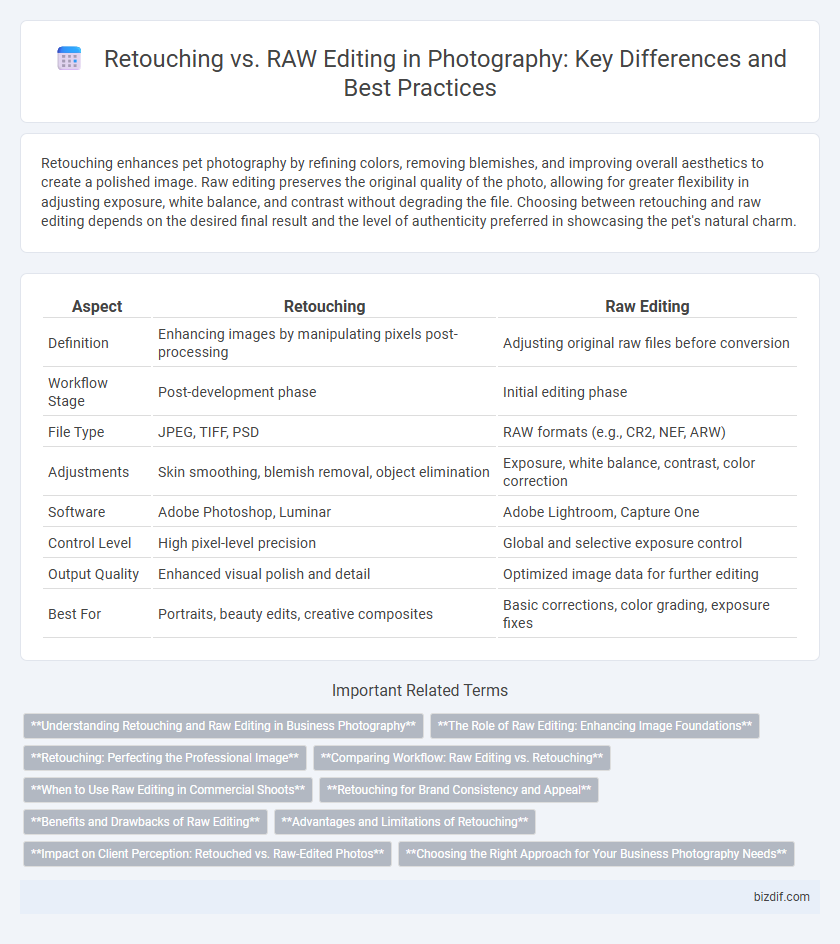Retouching enhances pet photography by refining colors, removing blemishes, and improving overall aesthetics to create a polished image. Raw editing preserves the original quality of the photo, allowing for greater flexibility in adjusting exposure, white balance, and contrast without degrading the file. Choosing between retouching and raw editing depends on the desired final result and the level of authenticity preferred in showcasing the pet's natural charm.
Table of Comparison
| Aspect | Retouching | Raw Editing |
|---|---|---|
| Definition | Enhancing images by manipulating pixels post-processing | Adjusting original raw files before conversion |
| Workflow Stage | Post-development phase | Initial editing phase |
| File Type | JPEG, TIFF, PSD | RAW formats (e.g., CR2, NEF, ARW) |
| Adjustments | Skin smoothing, blemish removal, object elimination | Exposure, white balance, contrast, color correction |
| Software | Adobe Photoshop, Luminar | Adobe Lightroom, Capture One |
| Control Level | High pixel-level precision | Global and selective exposure control |
| Output Quality | Enhanced visual polish and detail | Optimized image data for further editing |
| Best For | Portraits, beauty edits, creative composites | Basic corrections, color grading, exposure fixes |
Understanding Retouching and Raw Editing in Business Photography
Retouching in business photography involves enhancing images by correcting imperfections, adjusting skin tones, and refining details to present a polished and professional look. Raw editing refers to processing uncompressed, high-quality RAW files, allowing photographers to optimize exposure, contrast, and color balance before retouching. Mastering both techniques ensures visually compelling images that effectively communicate a brand's professionalism and identity.
The Role of Raw Editing: Enhancing Image Foundations
Raw editing plays a crucial role in enhancing image foundations by allowing photographers to manipulate unprocessed data captured directly from the camera sensor, preserving maximum detail and dynamic range. It enables precise adjustments to exposure, white balance, contrast, and color calibration without degrading image quality, forming a solid base for further creative enhancements. Optimizing raw files ensures that subsequent retouching maintains fidelity, resulting in sharper, more vibrant final images with greater depth and clarity.
Retouching: Perfecting the Professional Image
Retouching involves detailed manipulation of images to enhance skin texture, remove blemishes, and refine facial features, producing a polished and flawless appearance. This process utilizes advanced tools like frequency separation and dodge & burn techniques to achieve a professional finish that raw editing alone cannot provide. Retouching is essential for delivering high-end portraits and commercial photography that demand meticulous perfection and visual impact.
Comparing Workflow: Raw Editing vs. Retouching
Raw editing involves adjusting exposure, white balance, and highlights to optimize image quality directly from the sensor data, preserving maximum detail and dynamic range. Retouching focuses on localized corrections such as skin smoothing, blemish removal, and fine detail enhancement, typically applied after raw adjustments to refine the image aesthetically. Workflow efficiency improves by starting with raw editing to establish a clean base, followed by targeted retouching to enhance specific elements without compromising the overall image integrity.
When to Use Raw Editing in Commercial Shoots
Raw editing is essential in commercial shoots when precise control over exposure, white balance, and color grading is required to meet brand standards. It enables non-destructive adjustments and access to maximum image data, preserving detail for high-quality output in print or digital media. Raw editing is ideal for complex lighting scenarios and when consistency across multiple images is crucial for professional presentation.
Retouching for Brand Consistency and Appeal
Retouching ensures brand consistency by applying uniform color grading, skin tone adjustments, and logo placement across all images, enhancing visual appeal and reinforcing brand identity. Unlike raw editing, retouching focuses on fine-tuning details such as blemish removal, contrast balance, and texture smoothing to maintain a polished, professional look that aligns with brand standards. This process transforms raw images into cohesive marketing assets that resonate with the target audience and elevate the brand's perceived value.
Benefits and Drawbacks of Raw Editing
Raw editing offers unparalleled control over exposure, white balance, and color grading, preserving maximum image detail and dynamic range for professional-quality results. The flexibility to non-destructively adjust parameters allows photographers to tailor images precisely without degrading original file quality. However, raw files are large and require specialized software, which can increase workflow complexity and processing time compared to editing standardized JPEG files.
Advantages and Limitations of Retouching
Retouching enhances photographs by allowing precise corrections such as blemish removal, skin smoothing, and color adjustments, delivering polished and visually striking images suited for commercial and portrait photography. However, retouching can be time-consuming and may sometimes compromise the original detail and authenticity of the photo, especially when overused. Unlike raw editing, which preserves the full image data for flexible adjustments, retouching primarily works on processed files, limiting fundamental changes to exposure and dynamic range.
Impact on Client Perception: Retouched vs. Raw-Edited Photos
Retouched photos often create a polished and idealized image that can enhance client satisfaction by meeting high aesthetic expectations, while raw-edited photos offer a more authentic and natural representation that may appeal to clients valuing realism. The choice between retouching and raw editing significantly influences client perception, affecting how professional, trustworthy, and relatable the photographer appears. Understanding client preferences for either flawless perfection or genuine authenticity helps photographers tailor their post-processing approach to optimize client engagement and satisfaction.
Choosing the Right Approach for Your Business Photography Needs
Choosing the right approach for your business photography needs depends on the desired final output and workflow efficiency. Retouching offers precision in enhancing specific image elements to align with brand aesthetics, while raw editing provides comprehensive control over exposure, color balance, and detail preservation from the original file. Understanding the balance between time investment and quality requirements ensures the selection of a method that optimizes both image impact and operational productivity.
Retouching vs Raw Editing Infographic

 bizdif.com
bizdif.com